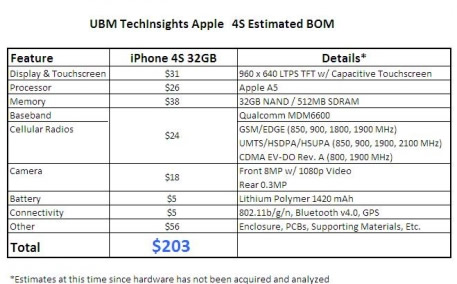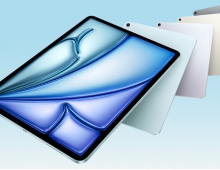
Teardown Analysis Shows That The 32GB iPhone 4S Costs Apple $203
The bill-of-materials (BoM) for the 32-GB version Apple's newly announced iPhone 4S is estimated to be about $203, roughly the same as the original iPhone 4's BoM when it was launched in mid-2010, according to a preliminary estimate by UBM TechInsights.
Using previous costing history and estimates on the major components of the iPhone 4S, UBM TechInsights estimates the bill-of-materials to be in the same range at where the iPhone 4 model was at launch in mid-2010. Using preliminary specs and cost analysis, the company estimates the 32GB
model of the iPhone 4S will have a BOM of $203 at launch. This estimate includes an estimated cost of $26 for the Apple A5 processor and $31 for the retina display.

"Technology-wise, you aren't seeing anything revolutionary or unexpected from the iPhone 4S", says Jeffrey Brown, Vice-President of Business Intelligence. "As we predicted in July, the iPhone 4S is a moderate improvement over the iPhone 4 - featuring an A5 processor that has been in use for approximately nine months, an image sensor that puts the handset on par with its competitors, and improved battery life."
The introduction of the iPhone 4S across GSM and CDMA networks in a singular design was also alluded to in the introduction of the Verizon model of the iPhone 4. "When the CDMA version of the iPhone 4 was brought to market, it featured a Qualcomm baseband modem that was capable of working across both networks", says Jeffrey Brown, "this was the single biggest indicator that Apple was moving towards a 'world phone' that would reduce design times and production costs. There would no longer be the need to produce two phones for different carriers to choose from. We expect the new antenna design to be very similar to what we saw in the CDMA version of the iPhone 4".
UBM TechInsights Vice-President of Technical Intelligence, David Carey, views today?s announcement of the iPhone 4S as par for the course for Apple. "Just as we saw a modest technology bump from the iPhone 3G to the iPhone 3GS, Apple is adopting the same model of iterative improvement and incrementalism as they gear up for the iPhone 5 platform. By continuing down the hardware evolution path, more powerful and useful software such as natural voice-recognition, highly-rendered gameplay, wireless video mirroring, and complex image processing all become possible. The software experience - enabled by 'good-enough' hardware - is arguably what customers care about most in the end".
One interesting revelation from Apple's announcement was the company's decision to forego the implementation of LTE in the iPhone 4S. "Apple is making a rather large statement on their confidence in LTE by focusing a lot of their presentation on the comparable rates of transfer of HSPA+ to LTE", says David Carey. "LTE implementation has brought about concerns of power consumption, but I believe in Apple's case, the decision to shy away from LTE comes from its slow adoption. For example, AT&T, the iPhone's original carrier, has yet to introduce 4G networks to their customers."
According to market research firm IHS iSuppli, Apple is likely to introduce an LTE-capable iPhone 5 when an affordable chipset solution allowing a thinner form factor is available, likely in late 2012 or in mid-2013.

"Technology-wise, you aren't seeing anything revolutionary or unexpected from the iPhone 4S", says Jeffrey Brown, Vice-President of Business Intelligence. "As we predicted in July, the iPhone 4S is a moderate improvement over the iPhone 4 - featuring an A5 processor that has been in use for approximately nine months, an image sensor that puts the handset on par with its competitors, and improved battery life."
The introduction of the iPhone 4S across GSM and CDMA networks in a singular design was also alluded to in the introduction of the Verizon model of the iPhone 4. "When the CDMA version of the iPhone 4 was brought to market, it featured a Qualcomm baseband modem that was capable of working across both networks", says Jeffrey Brown, "this was the single biggest indicator that Apple was moving towards a 'world phone' that would reduce design times and production costs. There would no longer be the need to produce two phones for different carriers to choose from. We expect the new antenna design to be very similar to what we saw in the CDMA version of the iPhone 4".
UBM TechInsights Vice-President of Technical Intelligence, David Carey, views today?s announcement of the iPhone 4S as par for the course for Apple. "Just as we saw a modest technology bump from the iPhone 3G to the iPhone 3GS, Apple is adopting the same model of iterative improvement and incrementalism as they gear up for the iPhone 5 platform. By continuing down the hardware evolution path, more powerful and useful software such as natural voice-recognition, highly-rendered gameplay, wireless video mirroring, and complex image processing all become possible. The software experience - enabled by 'good-enough' hardware - is arguably what customers care about most in the end".
One interesting revelation from Apple's announcement was the company's decision to forego the implementation of LTE in the iPhone 4S. "Apple is making a rather large statement on their confidence in LTE by focusing a lot of their presentation on the comparable rates of transfer of HSPA+ to LTE", says David Carey. "LTE implementation has brought about concerns of power consumption, but I believe in Apple's case, the decision to shy away from LTE comes from its slow adoption. For example, AT&T, the iPhone's original carrier, has yet to introduce 4G networks to their customers."
According to market research firm IHS iSuppli, Apple is likely to introduce an LTE-capable iPhone 5 when an affordable chipset solution allowing a thinner form factor is available, likely in late 2012 or in mid-2013.





















